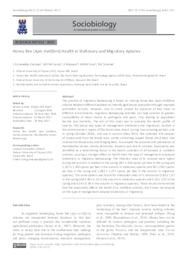Honey bee (Apis mellifera) health in stationary and migratory apiaries.
Honey bee (Apis mellifera) health in stationary and migratory apiaries.
Author(s): CESTARO, L. G.; ALVES, M. L. T. M. F; MESSAGE, D.; SILVA, M. V. G. B.; TEIXEIRA, E. W.
Summary: The practice of migratory beekeeping is based on moving honey bee (Apis mellifera) colonies between different locations to intensify agricultural production through improved pollination services. However, due to stress caused by exposure of bee hives to different environments, migratory beekeeping activities can lead colonies to greater susceptibility of these insects to pathogens and pests, thus leading to population decline and mortality. The aim of this study was to evaluate the health profile of apiaries that adopt two types of management (stationary and migratory), located in the central-eastern region of São Paulo state, Brazil, during two sampling periods, one in spring (October 2010), and one in autumn (May 2011). We collected 474 samples of honeycomb from the brood area, combs containing capped brood, adult bees that covered the brood area, and foraging bees, to evaluate the presence and prevalence of Paenibacillus larvae, Varroa destructor, Nosema apis and N. ceranae. Seasonality was identified as a determining factor in the health condition of Africanized A. mellifera colonies, causing a stronger effect on health than the type of management employed (stationary vs migratory beekeeping). The infection rates of N. ceranae were higher during the autumn in relation to the spring (387 ± 554 spores per bee in the spring and 1,167 ± 1,202 spores per bee in the autumn in stationary apiaries and 361 ± 687 spores per bee in the spring and 1,082 ± 1,277 spores per bee in the autumn in migratory apiaries). The same pattern was found for infestation rates of V. destructor (2.83 ± 1.97 in the spring and 9.48 ± 6.15 in the autumn in stationary apiaries and 3.25 ± 2.32 in the spring and 6.34 ± 6.58 in the autumn in migratory apiaries). These results demonstrate that the seasonality affects the health of A. mellifera colonies, but it does not depend on the type of management adopted (stationary or migratory).
Publication year: 2017
Types of publication: Journal article
Unit: Embrapa Dairy Cattle
Observation
Some of Embrapa's publications are published as ePub files. To read them, use or download one of the following free software options to your computer or mobile device. Android: Google Play Books; IOS: iBooks; Windows and Linux: Calibre.
Access other publications
Access the Agricultural Research Database (BDPA) to consult Embrapa's full library collection and records.
Visit Embrapa Bookstore to purchase books and other publications sold by Embrapa.

